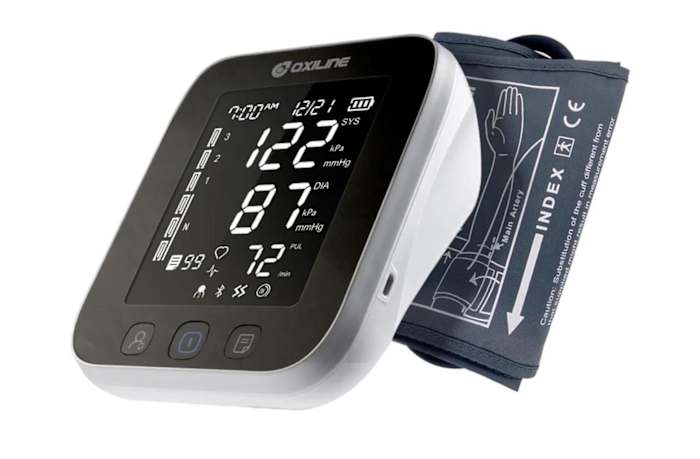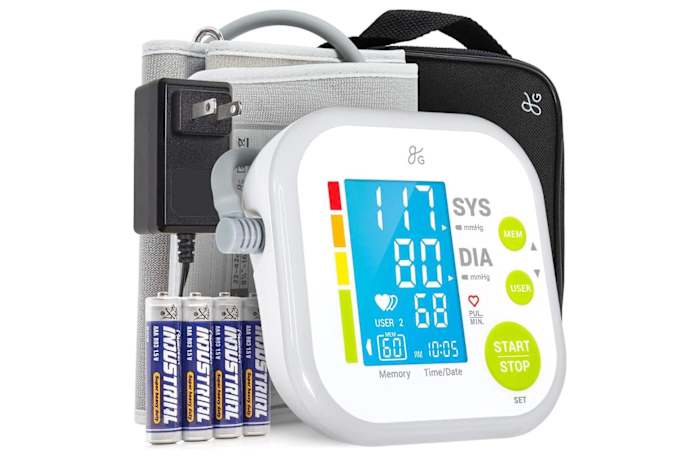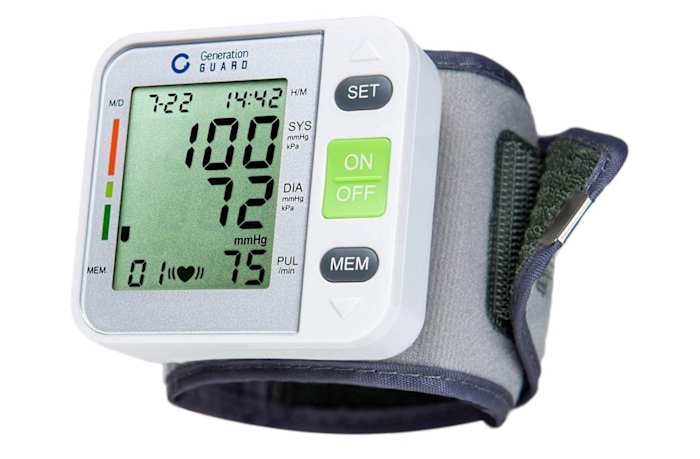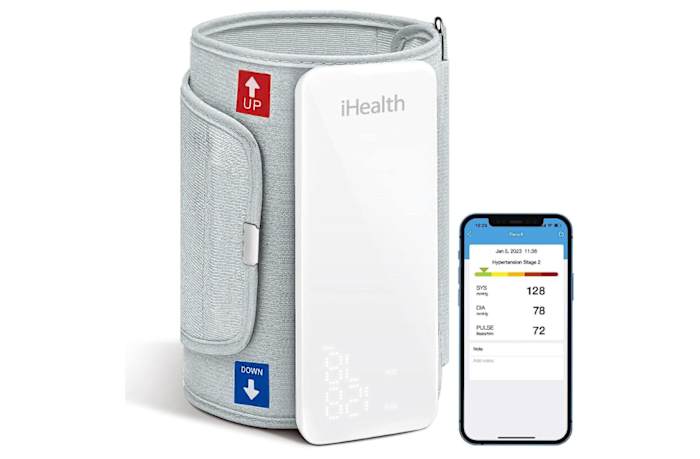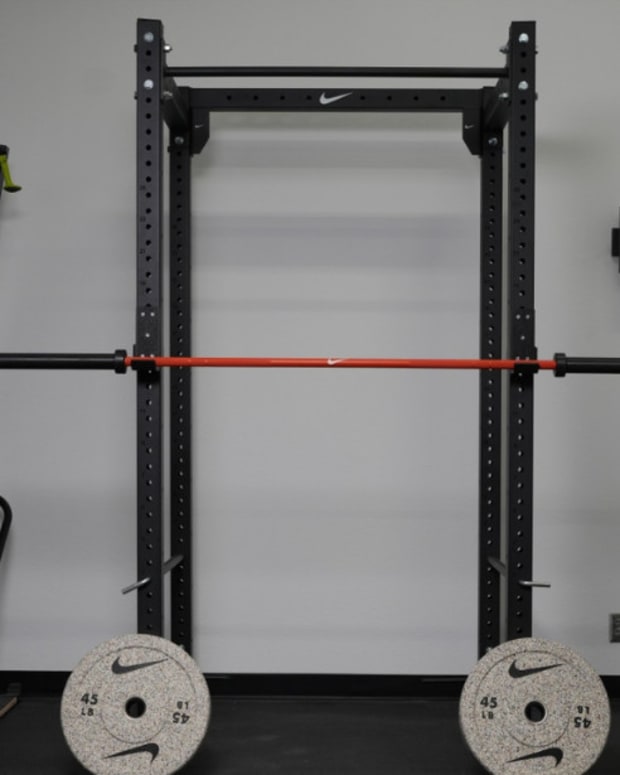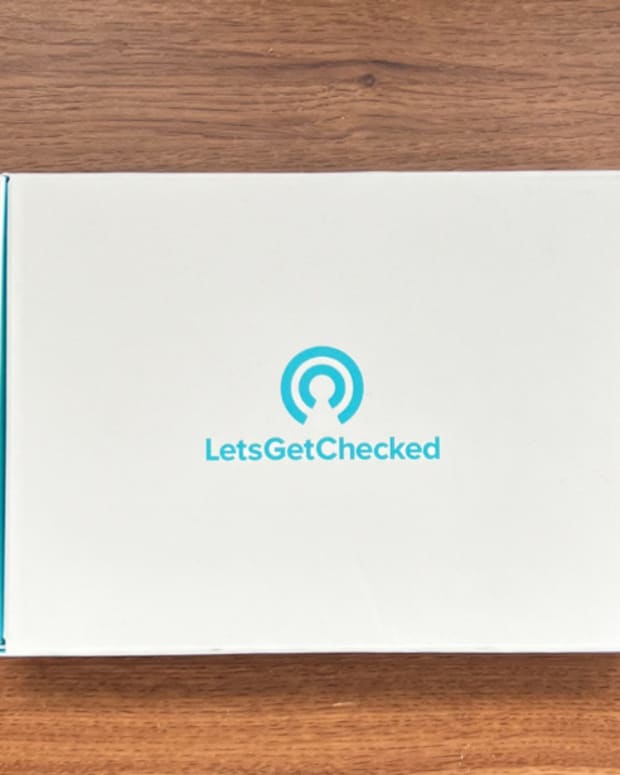The products featured in this article have been independently reviewed. When you buy something through the retail links on this page, we may earn commission at no cost to you, the reader. Sports Illustrated editorial staff are not involved in the creation of this content. Learn more here.
While rarely mentioned alongside pre-workout or protein drinks, blood pressure monitors, like heart rate monitors or pulse oximeters, can be critical in preserving one's well-being and long-term fitness abilities. Blood pressure monitors can save you money on visits to the cardiology clinic by helping prevent and diagnose hypertension and preemptively catching potential health issues. According to a study by the American Heart Association, many American adults struggle with hypertension, many of whom experience uncontrollable hypertension (with athletes in many cases facing even higher, more problematic levels of hypertension). The AHA says that consistent blood pressure monitoring outside of a doctor's office or store readings can help to offer an adult a more precise diagnosis of their hypertension, what may be contributing to it and the potential health risks they face (heart attacks, heart failure or stroke, to name a few).
Suppose you're a gym rat or just trying to get back in shape. In that case, a home blood pressure monitor can be a helpful tool in ensuring your well-being during training and throughout the day. With that said, I spent some time going through the best at-home blood pressure monitors available today with the hopes of helping you pick the right one for you, your health and your fitness routine.
This content is meant to be informative, but should not be taken as medical advice. It is not intended for use as diagnosis, prevention or treatment of health problems. Always speak with your doctor before starting any new supplement or exercise regimen.
Our Picks for the Best Blood Pressure Monitor:
- Best Overall Home Blood Pressure Monitor: Oxiline Pressure X Pro
- Best Budget Home Blood Pressure Monitor: Greater Goods Blood Pressure Monitor
- Best Wrist Blood Pressure Monitor: Generation Guard Automatic Blood Pressure Monitor
- Best Wireless Blood Pressure Monitor: iHealth Blood Pressure Monitor
- Best Portable Blood Pressure Monitor: Oxiline Pressure X Pro
Best Overall Home Blood Pressure Monitor: Oxiline Pressure X Pro
- Battery source: Four AA batteries
- Number of Readings Stored: Unlimited readings
- Number of Users: Unlimited users
- Type: Digital
- Best for: Individuals prone to hypertension seeking accurate blood pressure readings, athletes concerned about their blood pressure levels
- Price: $119
What we like:
- LCD monitor display
- VIBRA TX sensor technology
- Stores unlimited readings
What to consider:
- It is not rechargeable and requires AA batteries
The Pressure X Pro from Oxiline provides a top-tier blood pressure monitor that uses the most up-to-date sensor (VIBRA TX) technology to deliver some of the most accurate blood pressure readings from home. The FDA-approved Pressure X Pro offers more than a simple blood pressure reading. The monitor is Bluetooth capable and has its own Android and Apple-compatible app. The app alone makes the Pressure X stand out, offering unlimited blood pressure readings that can be both stored or exported to another device (great for bringing to the doctor). Furthermore, the app will inform you if it discovers problematic readings, helping you catch health concerns before they become too much.
While the cuff is not universal, Oxiline offers a standard (8.7-14.2 inches) and large cuff (8.6- 16.5 inches) version, which should make it accessible to most users. The LCD monitor and cuff are easily compacted in the included carrying case with purchase. While the monitor may be a bit more expensive than other blood pressure reading devices, its modern app-compatible attributes distinguish and help rationalize the price difference, especially considering the additional readings offered by its app. Overall, the Pressure X Pro's precision readings, FDA approval and app components make it a top smart blood pressure monitor.
Best Budget Home Blood Pressure Monitor: Greater Goods Blood Pressure Monitor
- Battery source: Four AAA batteries
- Number of Readings Stored: Stores up to 60 blood pressure measurements
- Number of Users: Two
- Type: Digital
- Best for: Athletes with diabetes, athletes engaged in cardio-intensive training, individuals concerned about having hypertension
- Price: $37.88
What we like:
- It can be plugged into the wall
- Comfortable upper arm cuff
- Stores up to 60 blood pressure readings
What to consider:
- It is not rechargeable and requires four AAA batteries
- Not compatible with smartphone applications or Fitbits
The Greater Goods upper arm blood pressure monitor provides comprehensive digital accounts of your blood pressure levels. The monitor is available for $37.88 on Amazon, making it an affordable tool to track your blood pressure and reduce your visits to the doctor. The Greater Goods monitor is suitable for two users and can store upwards of 60 measurements for each individual (helping you and your home or gym partner track your blood pressure over time). The monitor's measuring cuff is produced with plush fabric to be comfortable on the arm and designed to be accessible for all arm sizes. The digital reader works wirelessly, and despite not being rechargeable (it requires a plug-in or four AAA batteries), it has a reportedly long life span before needing to replace its batteries.
Furthermore, when the monitor's cuff inflates, your blood pressure reading begins, distinguishing the Greater Goods monitor from 80 percent of blood pressure monitors today. The monitor is compacted in a travel-friendly sized bag included with your purchase, making it easy to bring to the gym or when you're on the road. The Greater Goods home blood pressure monitor is an easy-to-use and practical monitor that can help you keep track of your health at a bargain rate in real time from home.
Best Wrist Blood Pressure Monitor: Generation Guard Automatic Blood Pressure Monitor
- Battery source: Two AAA batteries
- Number of Readings Stored: 90 readings
- Number of Users: One
- Type: Digital
- Best for: Athletes concerned about their blood pressure who prefer wrist-based blood pressure monitors over arm cuffs
- Price: $59.95
What we like:
- A great alternative to tight or uncomfortable arm cuff blood pressure readers
- Informs you of early signs of irregular heartbeat issues or hypertension
What to consider:
- Limited to 90 readings and is not smartphone compatible
- Batteries must be replaced
Generation Guard's FDA-approved blood pressure monitor offers accurate and easy readings by attaching the device around your wrist rather than requiring an inflatable blood pressure cuff. For those who find the tightness of arm cuff readings uncomfortable, this is a great alternative to stay up-to-date with your blood pressure and any irregularities with your heart levels. The adjustable cuff size is all-ages friendly, making it accessible to most people. The device can store up to 90 blood pressure readings, making it easy to keep track of any irregularities or better understand which days or activities may trigger high blood pressure that can decrease blood flow and oxygen to your heart.
Furthermore, the monitor offers both systolic pressure (the measurement of blood pressure in your arteries when your heart beats) and diastolic blood pressure (the measurement of blood pressure in your arteries when your heart rests between beats) readings and is designed to inform you of any early signs of problematic heartbeat or hypertension. Notably, the monitor includes the wrist cuff, user manual, a travel pack and batteries to get you started with your initial purchase, so you can be ready to go. Generation Guard suggests using this monitor 30 minutes after intense exercise for the most accurate reading, making it a great and compact tool to understand your health with precision and the effects of your training regimen on your blood pressure.
Related Post: The Best Blood Pressure Watches
Best Wireless Blood Pressure Monitor: iHealth Blood Pressure Monitor
- Battery source: Rechargeable lithium batteries
- Number of Readings Stored: Unlimited readings, 130 per battery charge
- Number of Users: Unlimited
- Type: Digital
- Best for: People who want a way to keep track of their blood pressure readings on their phone
- Price: $79.99
What we like:
- Rechargeable batteries
- The MyVitals connected app is compatible with both Android and Apple
- FDA and the European Society of Hypertension (ESH) approved
What to consider:
- Fans of wrist-based blood pressure monitors may not like the arm cuff design
The iHealth Neo Wireless blood pressure monitor incorporates the benefits of modern technology into your readings at an impressively affordable rate. The monitor is FDA-approved and in compliance with the European Society of Hypertension (ESH) standards, ensuring a clinical grade level of blood pressure reading accuracy. One of my favorite things about the iHealth monitor is that it uses rechargeable batteries that should last upwards of 130 measurements, saving you money and making it an eco-friendlier device. In addition, the iHealth monitor is Bluetooth and smartphone-compatible, offering unlimited readings to safely store in the device's MyVitals app. The app allows you to export your data storage into PDF or CSV files that you can bring to your next healthcare provider’s appointment and is compatible with Android and iOS phones. The app also consolidates your readings into a presentable chart that can help you notice fluctuations in your blood pressure that may be problematic and help you determine the potential causes of them.
The iHealth is easy and fast; with one push of a button, you can expect in-depth blood pressure and heart rate readings on your monitor and in the MyVitals app in 30 to 60 seconds, limiting excuses for not checking your stats. The iHealth monitor is relatively light and compact as well. The cuff is 0.75 inches thick, and the device weighs only 8.5 ounces. iHealth is a modern blood pressure monitor for a truly affordable rate of $79.99 on Amazon and is a go-to for those seeking a wireless and efficient blood pressure monitor for home monitoring.
Best Portable Blood Pressure Monitor: Oxiline Pressure X Pro
- Battery source: Four AA batteries
- Number of Readings Stored: Unlimited readings
- Number of Users: Unlimited users
- Type: Digital
- Best for: Individuals prone to hypertension seeking accurate blood pressure readings, athletes concerned about their blood pressure levels
- Price: $119
What we like:
- LCD monitor display
- Ultra accurate VIBRA TX sensor technology
- Stores unlimited readings
What to consider:
- It is not rechargeable and requires two AA batteries
Oxiline's Pressure X Pro is an FDA-approved Bluetooth-capable portable blood pressure monitor that enables you to test your blood pressure in the locker room after an intense workout or in your car after a rigorous session on the track. The monitor is compatible with Apple and Android smartphones and allows you to consolidate your readings over time to better understand how your daily routine affects your blood pressure. Furthermore, you can export your readings to a PDF file that you can easily share with your doctor or store on your computer to compare with other readings over time.
The Pressure X Pro offers a standard (8.7-14.2 inches) and a large arm cuff (8.6- 16.5 inches), making the monitor an accessible and comfortable choice for most people. In addition, the Pressure X Pro's cuff and monitor are designed to be easily compacted in a carrying case that is included with your purchase, making it a great tool for taking on the go. While its small and portable size makes it a practical blood pressure monitor for those who need readings outside the home, the Pressure X Pro uses some of the best sensor technology to date (VIBRA TX), giving accurate readings from home, on-the-road or wherever you use it. Despite being a bit pricier than other blood pressure monitors, Pressure X Pro's modern attributes, convenient portability and clinical approval (FDA-certified) make it my favorite portable at-home blood pressure monitor today.
What Is a Blood Pressure Monitor?
A blood pressure monitor is a device that measures an individual's blood pressure using a mercury or aneroid manometer. Whether manual or digital, BP monitors are considered a critical medical tool used in healthcare, as high or low blood pressure readings may be early signs of problematic health issues. High blood pressure usually has no warning signs or symptoms, but can cause a variety of issues ranging from hypertension, heart attacks or stroke. BPMs offer individuals a way to recognize their high blood pressure early and help prevent severe consequences in the long term.
Who Are Blood Pressure Monitors For?
Blood pressure monitors are typically for people with to high blood pressure or hypertension; which may include, but not be limited to seniors, people who drink too much alcohol or individuals with a history of high blood pressure in their family. However, while less discussed, athletes that engage in rigorous exercise may be prone to hypertension. Pete Nastasi, a certified nutrition coach and personal trainer, says that athletes could benefit from consistent blood pressure readings to ensure they are training correctly and preserving their health.
"Athletes, specifically larger ones such as bodybuilders or American football players, should have their blood pressure checked on a regular basis. Because of their size, they are prone to an increased risk of hypertension and the use of a blood pressure monitor during training can help ensure their health and safety," he said.
While monitoring blood pressure is useful, working to prevent high blood pressure can be beneficial, too. Consuming a heart-healthy diet is a good place to start. There is also some evidence that taking folic acid and vitamin b12 supplements may assist in lowering blood pressure.
How Do I Use a Blood Pressure Monitor?
A blood pressure monitor involves wearing a wrist or arm cuff that measures your blood pressure and reports it via a digital monitor or sphygmomanometer. The best way to use an at-home blood pressure monitor appropriately is to consult the device's user manual or your healthcare provider.
How to Choose the Best Blood Pressure Monitor for You
By determining your budget and needs for a blood pressure machine, you can likely grab the best one for at-home use. It's best to decide whether you want a digital or smart blood pressure monitor (like the Garmin Index BPM) or a more old-school straight-to-the-point reader. In addition, you should choose your budget for a blood pressure monitor and focus on blood pressure monitors that are within your means and have quality user reviews.
Our Methodology: How We Chose the Best Blood Pressure Monitor
Through reading various studies, receiving expert recommendations, analyzing user reviews and in-depth research, we consolidated our findings to determine the best blood pressure monitors available today.
Blood Pressure Monitors FAQs
How accurate are home blood pressure monitors?
Blood pressure monitors are typically quite accurate. According to a 2020 study, most inaccurate readings resulted from faulty devices more than four years old or when a cuff or arm monitor’s reader wasn’t worn correctly. Notably, for the most accurate results, always make sure you connect yourself to the monitor's cuff correctly and follow the device's user manual. Furthermore, I suggest getting a monitor that is FDA approved.
What is a normal blood pressure?
According to the Centers for Disease Control and Prevention, normal blood pressure is less than 120/80 millimeters of mercury (mmHg).
Can blood pressure monitors give incorrect readings?
Blood pressure monitors can give inaccurate readings. However, in many cases, according to the American Medical Association, this is due to an individual incorrectly wearing the cuff or wristband used to read one's blood pressure. It's best to always consult your blood pressure monitor's user manual before using a device.
What is the best time of day to take blood pressure?
According to an interview with a healthcare professional at Harvard Medical School, the best time to take your blood pressure is once in the morning and once in the evening. However, according to the CDC, athletes concerned about high blood pressure or hypertension should only use a blood pressure monitor thirty minutes after their workout.
How much should I spend on a blood pressure monitor?
How much you should spend on a blood pressure monitor depends on your budget and needs. You may want a simple reading, or you may want a monitor compatible with your smartphone. It's best to determine your needs and expectations from a blood pressure monitor, then compare this to your budget and choose one from there.
Does insurance cover an at-home blood pressure monitor?
Many insurance plans like Medicare and Caremark do cover blood pressure monitors. However, you should consult your insurance plan to ensure your plan does.
Takeaway: Is Having a Blood Pressure Monitor Worth It?
Blood pressure monitors can help you detect high blood pressure before experiencing the potential consequences of not addressing it (stroke, heart failure, etc.). Considering athletes are prone to hypertension, a blood pressure monitor can be a helpful tool in ensuring you are training safely. Blood pressure monitors are an affordable and incredibly beneficial tool in preserving one's well-being for the long term, and I'd strongly suggest getting one based on my research.
Prices are accurate and items in stock as of publish time.

